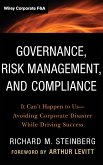State of the art risk management techniques and practices--supplemented with interactive analytics All too often risk management books focus on risk measurement details without taking a broader view. Quantitative Risk Management delivers a synthesis of common sense management together with the cutting-edge tools of modern theory.
Risk is at the core of any financial business. Quantitative Risk Management introduces the technical and managerial tools you need to assess and respond to risk. This comprehensive volume puts risk management in the hands of those on the front lines responsible for managing firms and their profits, and also provides readers access to a website that offers practical guidance for using the techniques discussed in the text. In recent years, risk tools and techniques have grown increasingly mathematical and technical. Yet risk management is much more than just numbers and must be placed in the context of the broader goals of managing people, processes, and institutions. Author and risk expert Thomas Coleman reconciles the mathematical and managerial elements of the field in a way that all financial professionals can understand. Understanding risk requires thinking carefully about uncertainty. Unfortunately, as humans we are often bad at doing so. Coleman introduces basic concepts in probability, focusing particularly on paradoxes and conundrums that highlight the errors and fallacies we can easily fall into in order to point you towards a deeper appreciation of how to think about, and manage, uncertainty. Of course, risk management requires knowledge and appreciation of technical tools. This book details the techniques and formulas used to calculate risk, covering both fundamentals and advanced topics in a clear, accessible way. Coleman introduces and explains quantitative tools including volatility, VaR, contribution to risk, best hedges, and many others. Beyond the numbers, Coleman takes you through issues such as managing people, data and IT, and infrastructure. In the end, risk management is about building a culture and organization that can respond to risk and withstand unanticipated events. Innovative, wide-ranging in scope, and bringing the essentials of managing risk to life, Quantitative Risk Management uniquely combines the models, tools, and techniques that anyone working in the financial field must understand to build better, safer risk management practices.
Risk is at the core of any financial business. Quantitative Risk Management introduces the technical and managerial tools you need to assess and respond to risk. This comprehensive volume puts risk management in the hands of those on the front lines responsible for managing firms and their profits, and also provides readers access to a website that offers practical guidance for using the techniques discussed in the text. In recent years, risk tools and techniques have grown increasingly mathematical and technical. Yet risk management is much more than just numbers and must be placed in the context of the broader goals of managing people, processes, and institutions. Author and risk expert Thomas Coleman reconciles the mathematical and managerial elements of the field in a way that all financial professionals can understand. Understanding risk requires thinking carefully about uncertainty. Unfortunately, as humans we are often bad at doing so. Coleman introduces basic concepts in probability, focusing particularly on paradoxes and conundrums that highlight the errors and fallacies we can easily fall into in order to point you towards a deeper appreciation of how to think about, and manage, uncertainty. Of course, risk management requires knowledge and appreciation of technical tools. This book details the techniques and formulas used to calculate risk, covering both fundamentals and advanced topics in a clear, accessible way. Coleman introduces and explains quantitative tools including volatility, VaR, contribution to risk, best hedges, and many others. Beyond the numbers, Coleman takes you through issues such as managing people, data and IT, and infrastructure. In the end, risk management is about building a culture and organization that can respond to risk and withstand unanticipated events. Innovative, wide-ranging in scope, and bringing the essentials of managing risk to life, Quantitative Risk Management uniquely combines the models, tools, and techniques that anyone working in the financial field must understand to build better, safer risk management practices.








